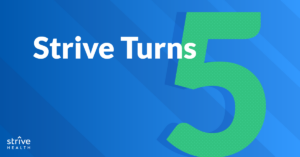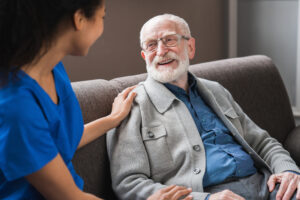A Donor’s Story: ‘I’m Just a Regular, Healthy Person Who Stepped Up’
Author : Strive Health
More than 90,000 people in the United States are waiting for a kidney transplant. Emily McIntire, RN, BSN, experienced the human side of those numbers daily in her work as an acute care dialysis nurse.
McIntire ultimately decided to become a living kidney donor, changing the life of a 21-year-old man with kidney failure.
McIntire is now a nurse care manager at Strive Health and part of the Kidney Heroes™ team. She works with people to slow the progress of their kidney disease through lifestyle changes and medical care so that if they need a transplant, they’ll be as healthy as possible.
We asked her about her experience as a donor and what she’d say to people considering kidney donation.
Q: Tell us about yourself and your work as a kidney care nurse.
A: I was born and raised in rural Indiana and graduated from Ball State University in Muncie, Indiana, where I live today in a historic house near downtown. I’m 42, no kids, just my cat. I began my career as an operating room nurse, then specialized in ophthalmology. I switched to dialysis nursing in 2009.
I started at Strive in January 2022. I’m a longitudinal care manager, so I reach out to our patients and assess their needs. I also make sure they are educated on all the types of dialysis once they get to that point.
Q: Why and how did you decide to become a kidney donor?
A: I had a patient die in 2019 after waiting over four years for a transplant. That’s when I started to think more about being a donor. Still, it was just something in the back of my mind as a “someday” thing.
Then at the end of 2020, one of my patients had a living donor that fell through, and I saw how difficult that news was for him. I decided to get a donor medical evaluation, thinking that maybe I’d be a match for him.
I made sure to clear it with his nephrologist and social worker, and I did not tell my patient. He only knew that an anonymous donor had stepped up.
Q: Once you decided to become a donor, what happened next?
A: I worked with Indiana University Health in Indianapolis, and I can’t say enough good things about the process or the team there. I filled out a form, and my coordinator contacted me a few days later, on Jan. 6, 2021.
I did all my required tests as soon as possible: electrocardiogram (EKG), chest X-ray, 24-hour urine collection, blood work, and computerized tomography (CT) scan of my kidneys and bladder.
I also met with a psychologist, a social worker and a patient advocate. They are very clear every step of the way that you can change your mind.
By mid-April 2021, I was approved as a left-sided kidney donor. However, it turned out that even though my patient and I were a blood-and-tissue-match, the difference in our height and weight (I’m 5-foot-2; he’s 6-foot-3 and twice my weight) was too significant to allow me to donate to him.
In the past, that would have been the end of my story. But not anymore. Now there’s “paired donation.”
I explain it as like an amusement park’s fast-pass program. Because I was approved to donate on my patient’s behalf, he got on a fast track for the next living donor match. And the IU Health team identified a recipient match for me.
On July 12, 2021, I became an official member of what living kidney donors call the “One Bean Club.”

Q: How did surgery and recovery go?
A: I struggled a bit with post-op nausea but not much pain, thanks to a nerve block. I have three tiny incisions from the laparoscopes and one long horizontal one on my abdomen, like a Cesarean section (C-section) scar.
I had set a goal in 2021 to do at least 20 minutes of physical activity every day. I didn’t let surgery stop me. After two days, I came home from the hospital, and my friends walked (very slowly!) with me around the block. Soon, I was walking farther on my own every day.
Fast forward: I continued to increase my activity by walking, hiking and running. Since surgery, I’ve run two quarter trail marathons (6.5 miles each) and I am training for the Indy mini half-marathon in May.
Q: Were you worried about the surgery and any long-term consequences?
A: I had never had surgery before, so I was a little nervous. I was also worried about being able to resume the activities I love, like hiking and running. Kidney Donor Athletes is an organization that supports and educates people about kidney donation. They paired me with a mentor who helped me through recovery.
Q: How much time did you have to take off from work?
I was off work for five weeks. Some people need longer — six to eight weeks. I combined paid time off (PTO) with short-term disability, which paid 60% of my salary. I had some help from family, to be honest, so I didn’t apply for financial assistance, but there are programs out there that can help with that.
Q: Have you met the young man who received your kidney?

A.: It’s not automatic that a donor and recipient meet. Both people must agree. But, yes, I did meet the young man in the hospital, thanks to my patient advocate. That was an incredibly powerful moment. Evan Ratney is 21 years old, from Gary, Indiana.
In high school, Evan’s life was interrupted by kidney failure related to lupus. Now he can go to college – he wants to study graphic design — and push the “play” button on his life again. His family is incredibly sweet, and we’re still in touch.
Q: What about your former patient, the person who inspired you to donate?
A: In August 2021, my patient advocate put together a video call with him and the woman who was his direct donor. He was confused at first about why his former dialysis nurse was on the call! Then when we told him that I was his indirect donor, he was practically speechless.

Q: What do you want people to know about your experience and kidney donation?
A: Many people don’t know that you can donate without being a match for someone specifically. If you respond to a request for a donor from someone and don’t match, you can enter the paired donation process as I did.
I think everyone should know that the recipient’s insurance covers all the donor’s medical costs. I didn’t pay a dime.
If you’re going to donate, you need a support system in place. I couldn’t have done this without the support of my parents and my circle of fantastic friends who helped me scoop kitty litter, do the laundry and cook meals.
Many people, when they hear I’m a donor, say things like, “That’s so brave,” or “You’re a hero.” I would like to change the narrative so that donation is looked at as a good thing, of course, but not something that only “special” people do. I’m just a regular, healthy person who saw a need and stepped up.
Learn more about living donation
April is Donate Life Month, but people are waiting every month of the year for life-saving transplants. Find out more about living donation from the National Kidney Foundation.








